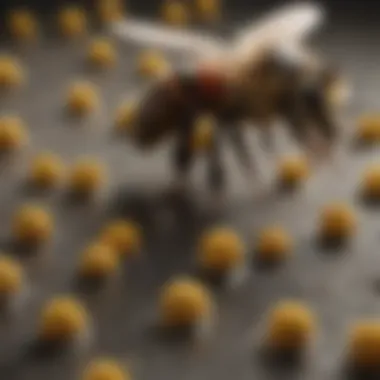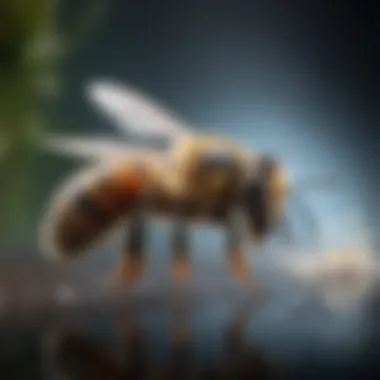Exploring Bee Spray Options on Amazon


Intro
The proliferation of bees in urban and suburban areas has created a complex relationship between homeowners and these essential pollinators. While bees play a pivotal role in ecosystem health and agriculture, their presence can also lead to problems for those allergic or especially in close proximity to their nests. Understanding the options available for bee management is crucial. This article aims to clarify the diverse bee sprays offered on Amazon, emphasizing their compositions, effectiveness, and safety for both users and the environment.
Pest Identification
Identifying the type of bee or wasp causing concern is the first step in addressing any pest issue. Common pests include:
- Honey Bees: Typically less aggressive, honey bees are crucial for pollination but may become problematic if their hives are disturbed.
- Bumblebees: These large, fuzzy bees are also valuable for pollination. Generally not aggressive, they may sting if threatened.
- Yellow Jackets: A type of wasp known for their aggressive behavior, especially when guarding a nest. They can pose risks during outdoor activities.
- Paper Wasps: These wasps are less aggressive than Yellow Jackets but will defend their nests. Look for long, slender bodies and an elongated nest structure.
Signs and Symptoms of Infestations
Recognizing signs of bee infestations can help facilitate timely intervention:
- Increased Buzzing Sounds: A noticeable increase in buzzing indicates the presence of bees or wasps nearby.
- Visible Nests: Look for nests attached to garages, eaves, or trees. Nests can vary in size depending on the species.
- Bees Entering and Exiting: Observe areas where bees are frequently flying in and out, which indicates an active nest nearby.
Prevention Strategies
Taking proactive measures can significantly reduce the likelihood of bee infestations. Here are some effective strategies:
Home Maintenance Tips for Pest Prevention
- Regular Inspections: Check around your home regularly for signs of nests and remove potential nesting sites.
- Seal Cracks: Close off any gaps in windows and walls to prevent bees from entering the home.
- Proper Waste Management: Keep trash bins sealed and clean to reduce attracting bees with food waste.
Natural Deterrents and Barriers
- Essential Oils: Certain essential oils like peppermint and citronella may deter bees when sprayed in areas where they gather.
- Physical Barriers: Install screens on windows and doors to keep bees out without resorting to sprays.
Treatment Options
When prevention fails, various treatments can address bee issues effectively. Treatment choices include both chemical and natural options.
Overview of Chemical vs. Natural Treatments
- Chemical Treatments: Many commercial bee sprays contain chemicals like pyrethroids, which kill pests on contact but may have ecological implications.
- Natural Treatments: Products with natural ingredients can be equally effective and less harmful to beneficial insects, though they may require repeated applications.
Step-by-Step Guides for DIY Treatments
- Identify the Species: Determine which type of bee or wasp you are dealing with to choose an appropriate treatment.
- Select Your Spray: Purchase a suitable spray based on your research, considering ingredients and user reviews. Check Amazon for a variety of options available.
- Follow Instructions: Carefully read and follow the product guidelines for safe application.
- Monitor Results: After treatment, keep an eye on the area for any signs of returned activity.
"Understanding the ecological ramifications of using bee sprays is essential for responsible pest management."
By being informed about the types of bee sprays available on Amazon and their effects, homeowners can make better decisions regarding the management of bee populations near their properties. The importance of bees in our ecosystem compels us to address their presence with care and responsibility.
Intro to Bee Sprays
Bee management is a critical aspect of maintaining a healthy environment in and around homes. Understanding the various options for bee sprays is essential for homeowners and anyone dealing with bee-related issues. Bees play a vital role in pollination, yet they can become invasive when they nest too close to human habitation. This article will explore the different kinds of bee sprays available on Amazon, offering insights into their uses, effectiveness, and safety considerations.
Importance of Bee Management
Effective bee management goes beyond mere elimination. It involves recognizing the ecological significance of bees. They contribute to the pollination of plants that produce fruits and vegetables, which are essential for food security. Ignoring bee-related concerns can lead to unintended environmental consequences. Choosing the right spray can help control bee populations without harming the bees that contribute positively to the ecosystem. Homeowners should approach bee management with this balance in mind.
Overview of Pesticidal Solutions
Pesticidal solutions are formulated substances designed to mitigate pest problems, including bees. These solutions can vary significantly in composition and effectiveness. Understanding the distinctions between different types of sprays is important for making educated choices.
There are two primary categories of bee sprays: synthetic and natural. Synthetic sprays often contain chemical compounds that can be very effective but may also pose environmental hazards. Natural sprays, on the other hand, generally contain botanical extracts that are less harmful to the ecosystem but might require more frequent application for effectiveness. Knowledgeable consumers can weigh these factors when selecting a product.
Additionally, understanding the specific scenarios in which various sprays are applied is crucial. For instance, sprays designed for immediate killing of bees may differ greatly from those intended for repelling bees. By familiarizing themselves with the available options, homeowners can choose the product that aligns best with their needs and safety concerns.
"Effective bee management requires a balance between controlling pest populations and protecting the ecological contributions of bees."
Categories of Bee Sprays Available on Amazon
The landscape of bee sprays available on Amazon is diverse and reflects a range of preferences and needs from consumers. Understanding the categories helps to navigate the choices effectively and allows for informed decisions about bee management. Each category offers unique ingredients, application techniques, and effectiveness, which are pivotal in choosing the right product for specific situations. Moreover, these choices can reflect one's ecological values and safety considerations.
Insecticidal Sprays


Insecticidal sprays represent a significant category of bee sprays. These products typically contain synthetic chemicals designed to target and eliminate pests, including bees and wasps. It is important to note that while effective, the use of insecticidal sprays carries certain risks. Homeowners must consider the potential harm to beneficial insects, particularly pollinators. Many insecticidal sprays work quickly, providing rapid relief from unwanted pests. However, users should follow directions carefully to minimize environmental impact. Specific examples of insecticidal sprays include Raid Wasp and Hornet Killer and Ortho Home Defense Max.
- Advantages:
- Disadvantages:
- Quick action.
- Broad spectrum of effectiveness against various insects.
- Potential harm to non-target species.
- Residues may linger in the environment.
Natural and Organic Options
Natural and organic bee sprays have gained popularity, appealing to those concerned about harming the environment. These products often rely on plant-based ingredients or essential oils, making them potentially safer for the ecosystem and users. Products like EcoSMART Organic Insect Killer and Homemade vinegar sprays fall under this category. While they may not provide the immediate results that synthetic options do, they often lessen the ecological footprint. Users value these sprays for their lower toxicity and pleasant fragrances.
- Advantages:
- Disadvantages:
- Generally safer for beneficial insects.
- Less harmful to human health.
- May require repeated application.
- Effectiveness can vary depending on the situation.
Professional-Grade Sprays
Professional-grade sprays are typically formulated for more extensive infestations and may be sold directly to pest control services. These products often contain more potent ingredients than those available to the average consumer. Users who decide on these sprays must approach with caution, as they may involve risks that should be properly managed. Brands like Talstar Professional and Demand CS are used by professionals and are known for their effectiveness.
- Advantages:
- Disadvantages:
- High efficacy in dealing with severe infestations.
- Longer residuality compared to consumer products.
- Requires knowledge and safety gear for proper application.
- Not always accessible for general consumers.
"Understanding the category of bee sprays you choose is key to effective pest management and minimizing harm to the environment."
In summary, each category of bee sprays serves distinct purposes and understanding their uses helps target solutions effectively. Evaluating the pros and cons is essential for any homeowner looking to manage bee populations responsibly.
Ingredients in Bee Sprays
Understanding the ingredients in bee sprays is essential for making informed decisions about pest control. The choice of ingredients not only determines the effectiveness of the spray but also influences health and environmental safety. Homeowners need to know what substances they are spraying in their living spaces and how these may affect their surroundings.
Synthetic Chemicals
Synthetic chemicals are a common component in many bee sprays available on Amazon. These compounds are specially formulated to target and eliminate bees quickly. Ingredients such as pyrethroids, often derived from chrysanthemum flowers, are frequently used due to their rapid action against insects. They work by disrupting the nervous system of bees, leading to fatality.
While effective, one must consider the implications of using synthetic chemicals. They can harm non-target species like beneficial insects and may pose risks to pets and humans. Studies have shown that improper handling or application can lead to exposure, raising concerns about long-term health effects.
Benefits:
- Quick elimination of pests.
- Widely available and often cost-effective.
Considerations:
- Potential residual effects on the environment.
- Risk to non-target organisms, including pollinators, pets, and people.
Natural Extracts
Natural extracts serve as an alternative to synthetic chemicals in bee sprays. Ingredients derived from plants, like peppermint oil or neem oil, can repel or kill bees without the harsh effects of chemical residues. Natural extracts often have a more favorable environmental profile, breaking down more easily compared to their synthetic counterparts.
Though these sprays are perceived as safer, their effectiveness can vary. Some might require multiple applications to achieve the desired results, leading to questions about their overall efficiency. Homeowners gravitating toward natural options should read product descriptions thoroughly, ensuring that the extracts used genuinely provide the sought-after benefits.
Benefits:
- Lower environmental impact.
- Safety for humans and pets when used as directed.
Considerations:
- May need more frequent application.
- Variable effectiveness based on the concentration and type of extract.
Potential Allergens
Another crucial concern regarding bee sprays is the potential for allergens. Many sprays contain ingredients that can cause allergic reactions in sensitive individuals. For example, synthetic fragrances or specific natural oils might trigger asthma or skin irritation in some people.


It is vital to consult labels and conduct patch tests when using new products. Understanding the potential allergens can aid in preventing adverse reactions, especially in family households with children or pets. A failure to recognize these allergens often leads to discomfort and health issues, underscoring the importance of knowing what is in the sprays being used.
Key Considerations:
- Always read labels for potential allergens.
- Conduct small tests before widespread use.
Evaluating Effectiveness
Evaluating the effectiveness of bee sprays is crucial for homeowners and pest control professionals alike. Selecting the right product relies on how well it can eliminate bees without causing harm to the environment or non-target species. Effectiveness can vary based on multiple factors. Understanding these will lead to informed choices that can save time, money, and ensure safety.
User Reviews and Ratings
User reviews and ratings play a significant role in assessing bee spray effectiveness. These firsthand accounts provide insight into how a product performs in real-world scenarios. Customers often share their experiences with various brands, detailing the outcomes of their pest control efforts. For example, if a user mentions that a specific spray was effective in a short duration, it may indicate that the product has a potent formulation. Additionally, negative feedback can highlight any shortcomings, such as ineffectiveness against certain bee species or adverse reactions.
When analyzing reviews, look for patterns in the responses. Consistent praise or criticism for a product can guide decision-making. Platforms like Amazon feature a filtering option that allows users to view only verified purchases, lending credibility to the reviews. Consequently, evaluating feedback and ratings can save buyers from poor choices.
Field Studies and Trials
Field studies and trials add another layer to understanding bee spray effectiveness. Scientific tests are often conducted to evaluate how different products perform under controlled conditions. These studies consider variables such as different concentrations, application methods, and environmental factors.
For example, studies may compare the efficacy of synthetic chemicals versus organic solutions, measuring their ability to reduce bee populations. Understanding the methodology and results from such trials helps consumers gauge which products may offer reliable results. Checking sources like universities or agricultural extensions can provide solid research data for various bee sprays.
Comparative Effectiveness Analysis
Conducting a comparative effectiveness analysis involves evaluating multiple products side by side. This approach can reveal which sprays are truly efficient in managing bee populations. Factors to consider include:
- Active Ingredients: Different ingredients may yield varying results against specific species.
- Formulation Type: Sprays in liquid or aerosol forms may differ in how they disperse and affect bees.
- Application Technique: The ease of use can determine how effectively the product is applied, influencing its success.
A comparative approach allows users to weigh pros and cons, ensuring they select a spray that meets their specific needs. This not only enhances effectiveness but also provides a better return on investment.
"Selecting a bee spray based on evidence and user feedback can significantly increase the chances of successful pest control."
By diving deep into each of these elements, you can make a more informed decision when choosing a bee spray that suits your requirements.
Application Techniques
Effective bee management extends beyond choosing the right spray. The application techniques are crucial to ensure that the selected solution produces optimal results while minimizing any adverse effects on the environment and the user. Understanding these techniques enables homeowners and DIY enthusiasts to use bee sprays efficiently, leading to more successful outcomes in pest control.
Best Practices for Use
When using bee sprays, it is essential to adopt best practices that enhance effectiveness and safety. Some important guidelines include:
- Read the Label: Always consult the pesticide label for specific instructions on how to apply it. Labels provide essential information, such as safety measures and mixing ratios.
- Timing of Application: The best time to apply sprays is in the late evening or early morning when bees are less active. This reduces the chance of harming beneficial pollinators.
- Targeted Application: Aiming the spray directly at nests can help minimize the amount of pesticide used. Use a precision nozzle for better control.
- Wear Protective Gear: Even if the product claims to be safe, wearing gloves and masks can help protect from irritation or allergic reactions. Always prioritize personal safety.
By following these practices, users can maximize the effectiveness of their bee sprays while reducing risks involved with application.
Safety Precautions
Safety is paramount when handling such chemicals. Bee sprays, even those labeled as natural, can pose risks if not used properly. Important safety precautions include:
- Avoid Inhalation: Ensure the area is well-ventilated during application. Inhaling spray mist can lead to respiratory issues.
- Keep Away from Children and Pets: Ensure that children and animals are kept at a safe distance during application and until the product has dried completely.
- Proper Storage: Store bee sprays in a cool, dry place, away from direct sunlight. Ensure that caps are secure to avoid leaks or spills.
- Emergency Plans: Familiarize yourself with first aid procedures in case of accidental exposure. Know the emergency contact for poison control in your area.
Implementing stringent safety measures helps mitigate the risks linked with chemical usage.
Environmental Considerations
Using bee sprays also presents environmental implications that customers must consider. Attention to the ecological impact of these products supports sustainable practices. Key considerations include:
- Non-Target Species: Many sprays can affect species beyond just the intended pests. This can damage pollinators and beneficial insects, leading to broader ecological disruptions.
- Soil and Water Contamination: Runoff from treated areas can contaminate local waterways and affect aquatic life. Identify how and where to spray to avoid runoff.
- Biodegradability: Opt for products that are labeled as biodegradable or environmentally friendly. Less persistent chemicals often present minimal risks to ecosystems.
"Being mindful of the environmental effects of bee sprays is not only responsible but can lead to healthier ecosystems and communities."
Ultimately, conscientious application techniques play a vital role in the safe, effective, and responsible management of bee populations. They help balance pest control needs with environmental stewardship, providing homeowners a path to manage bee-related concerns wisely.
Legal and Regulatory Aspects
Understanding the legal and regulatory aspects of bee sprays is crucial for consumers. This knowledge helps ensure that the products chosen are effective and safe for people, pets, and the environment. Different countries have established regulations that govern the sale and use of pesticides, including bee sprays. These regulations typically include pesticide registration, labeling requirements, and compliance standards.


Pesticide Registration
Pesticide registration is a key step in the approval process for any bee spray. In the United States, the Environmental Protection Agency (EPA) is responsible for this process. The aim is to assess the safety and efficacy of the product before it reaches the market. Manufacturers must submit detailed information regarding the ingredients, potential health impacts, and environmental effects.
This step is vital to ensure that any chemical used in residential environments has undergone thorough testing. Homeowners should look for sprays that are EPA-approved. This means the product meets required safety standards and has been scientifically evaluated for its intended purpose.
"Using an untested product can lead to unintended consequences, not just for bees but for the whole ecosystem."
Labeling Requirements
Labeling is another important element of pesticide regulation. Labels provide essential information about the product, including active ingredients, application instructions, and safety precautions. The EPA mandates that labels must be clear and easy to understand. This helps users follow directions carefully to minimize risk.
Look for labels that have the following information:
- Active ingredients listed clearly
- Directions for use and application
- Safety warnings for pets and humans
- Environmental impact statements
Labels not only guide correct application but also inform users about the potential risks associated with misuse. An informed home owner is better equipped to make decisions that ensure safety for their environment.
Compliance Standards
Compliance standards refer to the set of guidelines and regulatory mechanisms designed to monitor pesticide use. These standards can involve periodic inspections and retailer compliance checks. Regulatory bodies check to ensure that the products sold to consumers meet safety and environmental criteria.
For households, adhering to compliance standards means purchasing products from reputable sellers. Consumers should check for compliance with both local and national regulations. This can provide assurance of quality and safety when it comes to bee management
Engaging with these legal frameworks is essential for effective pest control. Awareness about registration, labeling, and compliance allows people to make informed choices while safeguarding their households and the environment.
Potential Alternatives to Bee Sprays
When addressing bee management, it is crucial to explore alternatives to bee sprays. These alternatives can offer effective pest control while minimizing environmental impacts and health risks. Understanding the options available allows homeowners to make informed decisions. The alternatives might not only protect property but also promote a more sustainable and harmonious approach to dealing with bees. Different methods can suit varying circumstances, from more natural tactics to professional interventions.
Physical Exclusion Methods
Physical exclusion methods focus on preventing bees from entering desired spaces. This method is very effective for those who prioritize non-chemical approaches. It includes sealing openings and removing attractants. Homes can often be sites for bees seeking safe nesting areas. To deter them, homeowners should inspect their structures for holes or cracks in the foundation, walls, or roof. Screens on windows and doors also block access effectively.
Benefits of Physical Exclusion Methods:
- Cost-Effective: Often requires minimal investment; using materials like caulk or mesh screens.
- Environmental Friendly: No chemical exposure, making it safer for children and pets.
- Long-Term Solutions: Once properly executed, can provide permanent protection against future infestations.
Natural Repellents
Natural repellents serve as an alternative for those averse to chemical pest control. Such options usually consist of essential oils or other natural ingredients. They can disrupt bees’ senses, leading them to avoid treated areas. For instance, substances like peppermint or vinegar have been noted to repel bees effectively. Homeowners can create sprays using these components at home.
Considerations for Using Natural Repellents:
- Potency Fluctuates: The effectiveness can vary based on environmental conditions, like rain or wind.
- Regular Application: Requires frequent reapplication to maintain effectiveness; generally less practical for heavy infestations.
- Planting Strategy: Incorporating repellent plants like marigolds or lemongrass in gardens can enhance repellent effects naturally.
Professional Pest Control Services
For more severe bee issues, turning to professional pest control services may be necessary. These experts assess the situation and apply targeted methods tailored to specific problems. They often employ both chemical and non-chemical techniques, depending on the case. Relying on trained specialists can not only save time but also ensure that effective measures are taken responsibly.
Key Benefits of Professional Services:
- Expertise: Professionals possess in-depth knowledge and experience that homeowners may lack.
- Safety Assurance: They are trained to handle pesticides safely and can follow regulations effectively.
- Comprehensive Solutions: They often provide long-term management plans, evaluating both immediate and future risks.
Utilizing alternatives to bee sprays not only helps manage bee populations effectively but also embraces more ecosystem-friendly practices. Homeowners should weigh their options carefully based on their particular needs and circumstances.
Finale
The conclusion serves as a critical component in this article on bee sprays available on Amazon. It wraps up the discussions made throughout the various sections, synthesizing the key points and providing a final perspective on bee management practices. Bee sprays have become important to homeowners seeking to manage bee populations effectively and safely.
Summary of Key Points
In this article, several points stand out about bee sprays and their management:
- Types of Sprays: We covered different categories of bee sprays, including insecticidal, natural, and professional-grade options. Each has its unique attributes, benefits, and considerations.
- Ingredients: Understanding the ingredients in these sprays is vital. This includes synthetic chemicals and natural extracts, as well as recognizing potential allergens.
- Effectiveness: Evaluating sprays based on user reviews and field studies highlights their varied effectiveness and guides consumer choices.
- Application Techniques: Best practices, safety precautions, and environmental considerations underpin successful and responsible usage of bee sprays.
- Legal Aspects: Awareness of pesticide registration and labeling requirements provides essential context for users to navigate the regulatory landscape.
- Alternatives: Exploring potential alternatives to bee sprays offers additional insight into managing bee interactions without relying solely on chemical solutions.
Future Perspectives on Bee Management
The landscape of bee management is evolving. Homeowners are increasingly aware of the ecological implications of pest control measures. Future perspectives indicate a trend towards more eco-friendly solutions, including the use of natural repellents and physical exclusion methods. Additionally, educational programs and resources are likely to grow, aiding individuals in making informed choices.
Furthermore, professional pest control services may incorporate more integrated pest management practices. This balanced approach seeks not only to eliminate pests but also to safeguard beneficial insect populations, such as pollinators.
In summary, understanding bee spray options is not just about selecting a product. It involves a thoughtful consideration of effectiveness, safety, and environmental impact. As we move forward, continued research and adaptation to local ecosystem needs will shape the future of bee management.



